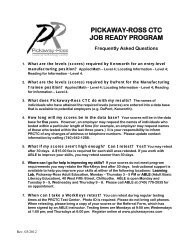Commons
Conceptual Physics - elearning-phys
Conceptual Physics - elearning-phys
- No tags were found...
Create successful ePaper yourself
Turn your PDF publications into a flip-book with our unique Google optimized e-Paper software.
The earth circles the sun, n, and we can therefore determinethe distances to a few hundred of the nearest stars by making observationssix months apart, so that the baseline for the parallaxmeasurement is the diameter of the earth’s orbit. For these stars,the distances derived from parallax can be checked against the onesfound by the method of example 2 on page 144. They do check out,which verifies the assumption that the stars are objects analogousto our sun.n / The nearer star has a largerparallax angle. By measuring theparallax angles, we can determinethe distances to both stars.(The scale on this drawing isnot realistic. If the earth’s orbitwas really this size, the neareststars would be several kilometersaway.)Reversibility of light raysThe fact that specular reflection displays equal angles of incidenceand reflection means that there is a symmetry: if the ray hadcome in from the right instead of the left in the figure above, the angleswould have looked exactly the same. This is not just a pointlessdetail about specular reflection. It’s a manifestation of a very deepand important fact about nature, which is that the laws of physicsdo not distinguish between past and future. Cannonballs and planetshave trajectories that are equally natural in reverse, and so dolight rays. This type of symmetry is called time-reversal symmetry.Typically, time-reversal symmetry is a characteristic of any processthat does not involve heat. For instance, the planets do notexperience any friction as they travel through empty space, so thereis no frictional heating. We should thus expect the time-reversedversions of their orbits to obey the laws of physics, which they do.In contrast, a book sliding across a table does generate heat fromfriction as it slows down, and it is therefore not surprising that thistype of motion does not appear to obey time-reversal symmetry. Abook lying still on a flat table is never observed to spontaneouslystart sliding, sucking up heat energy and transforming it into kineticenergy.Similarly, the only situation we’ve observed so far where lightdoes not obey time-reversal symmetry is absorption, which involvesheat. Your skin absorbs visible light from the sun and heats up,but we never observe people’s skin to glow, converting heat energyinto visible light. People’s skin does glow in infrared light, butthat doesn’t mean the situation is symmetric. Even if you absorbduring a solar eclipse, so that people at both locations would know they were insync.146 Chapter 7 The Ray Model of Light



